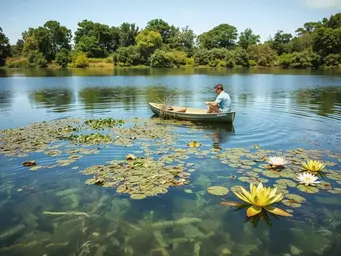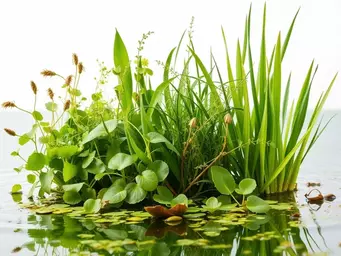🌿 Emergent Weeds
Grow above water (e.g., cattails, bulrushes).

Understanding the intricate dynamics of aquatic weeds is essential for maintaining the health of private ponds. By recognizing the types of weeds and their impacts, pond owners can implement effective management strategies.
Understanding the types of aquatic weeds and the practices for their safe and effective treatment is crucial for maintaining a healthy pond ecosystem. The visual below categorizes common weed types and outlines key treatment principles.
Grow above water (e.g., cattails, bulrushes).
Thrive underwater (e.g., coontail, hydrilla).
Float on surface (e.g., water hyacinth, duckweed).
Crucial for choosing the correct herbicide.
Tailor to specific weed types for efficacy.
Adhere strictly to dosage and timing.
Implement buffer zones to protect non-target species.
As an ecologist passionate about aquatic ecosystems, I've seen firsthand how aquatic weeds can affect the health of private ponds. Understanding the different types of weeds that inhabit these environments is crucial for their management. Let’s dive into the identification of these common types of aquatic weeds and learn how to recognize them effectively!
In private ponds, aquatic weeds can be categorized mainly into three types: emergent, submerged, and floating. Here’s how to identify each type:

Accurately identifying these weeds is the first step in effective management. Each type has unique characteristics that require specific treatment approaches. For comprehensive guides on aquatic plant identification, you can refer to resources like the National Center for Biotechnology Information (NCBI).
Misidentifying aquatic weeds can lead to ineffective treatment strategies and wasted resources. For instance, treating a submerged weed with a solution meant for emergent plants will likely yield poor results. This not only prolongs the issue but can also worsen the weed infestation.
By taking the time to learn about the weeds in your pond, you set yourself up for success in managing these invasive plants! Further insights into effective aquatic plant management can be found in publications from the Washington State Department of Ecology.
Aquatic invasive species pose a significant threat to the balance of pond ecosystems. They often outcompete native species for resources, leading to disruption of the natural ecosystem. This imbalance can amplify the problems associated with aquatic weeds, as invasives may create favorable conditions for their growth.
Recognizing the presence of invasive species in your pond can guide you in devising a comprehensive management plan. By engaging with Aquatic Weed Solutions, you can access resources that help in identifying these species and mitigating their impact.
To effectively manage aquatic weeds, consider implementing a regular monitoring schedule for your pond. By frequently assessing the health of your pond and identifying weed growth early, you can take timely action, preventing larger infestations and reducing the need for extensive treatments.
As we wrap up our discussion on effective weed management, it's crucial to recap the key elements that influence successful chemical treatments. Understanding weed identification, selecting the right herbicides, and applying them safely are foundational steps in maintaining a healthy pond ecosystem.

With a focus on safety and efficacy, here’s a summary of best practices to keep in mind:
By following these practices, you not only enhance the effectiveness of your treatments but also contribute to a healthier aquatic environment. For detailed guidance on herbicide application and safety, resources like the Texas A&M AgriLife Extension provide valuable information.
Here are some common questions about managing aquatic weeds in private ponds:
Now that you're equipped with knowledge about identification and treatment, it’s time to take action! I encourage you to develop your own treatment plan using the guidelines provided throughout this article. Consider creating a detailed outline that includes:
If you're looking for a more structured approach, don't forget to download our treatment calendar to help you track your progress and ensure timely interventions. Taking these steps will empower you to manage your pond effectively and sustainably!
I'm excited to hear from you! Share your experiences or questions in the comments section below. Your insights can help foster a supportive community among pond owners and enthusiasts alike. Together, we can navigate the challenges of aquatic weed management and promote healthier waterways.
So, what’s your story? Have you implemented any of these practices? Let’s connect and learn from one another!
Here is a quick recap of the important points discussed in the article:
Managing Aquatic Weeds Effectively

As we delve into the hidden challenges of our water ecosystems, understanding the role of aquatic we
Impact of Aquatic Weeds on Recreation

As we dive into the world of aquatic ecosystems, the presence of invasive aquatic weeds may not only
Understanding Aquatic Weed Varieties

What if understanding aquatic weeds could be the key to restoring our waterways? As we dive deeper i
Managing Aquatic Weeds Effectively
Impact of Aquatic Weeds on Recreation
Understanding Aquatic Weed Varieties
Integrated Aquatic Weed Management Methods
Integrated Approaches to Aquatic Weeds